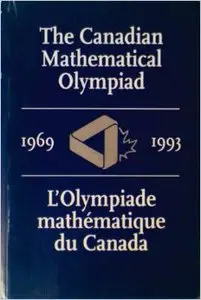Michael Doob, "The Canadian Mathematical Olympiad 1969-1993"
1993 | English, French | ISBN-10: 0919558054 | 280 pages | Djvu | 2 MB
1993 | English, French | ISBN-10: 0919558054 | 280 pages | Djvu | 2 MB
From the Preface:
Completing its first quarter century, the Canadian Mathematical Olympiad is one of the older national mathematics competitions. Younger than its
Eastern European counterparts, it predates the Olympiads of the USA, UK and most other countries that have participated in the International
Mathematical Olympiad. It is also quite large. More than 200 candidates from all ten provinces are nominated by provincial coordinators on the basis of regional contests, subject to quotas approximately proportional to population…
…The CMO problems sub-committee should embody a number of skills. Typically, each committee member proposes a few problems, but these have to be evaluated and often reformulated. Thus, it helps to have someone familiar with extant contest problems, someone who is a stickler for detail and can anticipate errors and misconceptions, and someone with a talent for rewording problems in a particularly clear or elegant way. During the first few years, the competitors were more naive and generally had only a background of standard high school courses. More recently, the top students have prepared themselves specifically for competitions, and exposed themselves to topics in geometry, combinatorics and algebra that went far beyond the ordinary curriculum.
Furthermore, thanks to resources like Crux Mathematicorum (a problems journal published by the Canadian Mathematical Society), students have become much more aware of the problem literature. Accordingly, it has become a serious challenge to set papers that would entice the better students with new problems while still keeping them accessible to the ordinary competitor. While acknowledging the fine work of all of the committees, mention in particular Murray Klamkin and Andy Liu for their expertise and inventiveness.
Having served on the CMO Committee in both the 1970s and the 1990s, I can see how the philosophy has evolved. Willy Moser, in particular, was anxious that competitors should not be discouraged and sought to have some problems that were interesting and readily solvable. The early CMO papers contained many more problems than they do now, and it was only in 1979 that the CMO developed into its present format of five problems, commencing with an easier "starter" question.
Committees have sought to vary the problems according to topic and skill requirements. While some problems might need a leap of insight or special
ingenuity, other problems should reward the competent and careful student.
Some problems might need only clear reasoning or a sure technique; others might be easy to see, but require a high level of exposition or attention to
detail so as to avoid pitfalls and ensure coverage of all possibilities…



